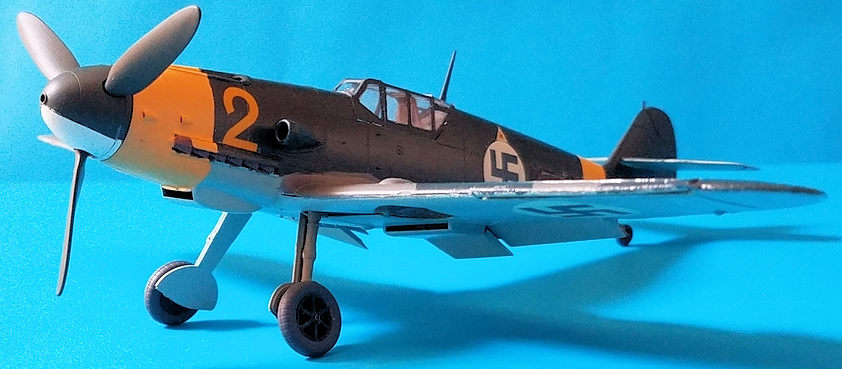
Eduard 1/48 Bf-109G-2
| KIT #: | 82116 |
| PRICE: | 1934 Euros |
| DECALS: | Five options |
| REVIEWER: | Francisco Santoro |
| NOTES: |
Hasegawa decals used |

| HISTORY |
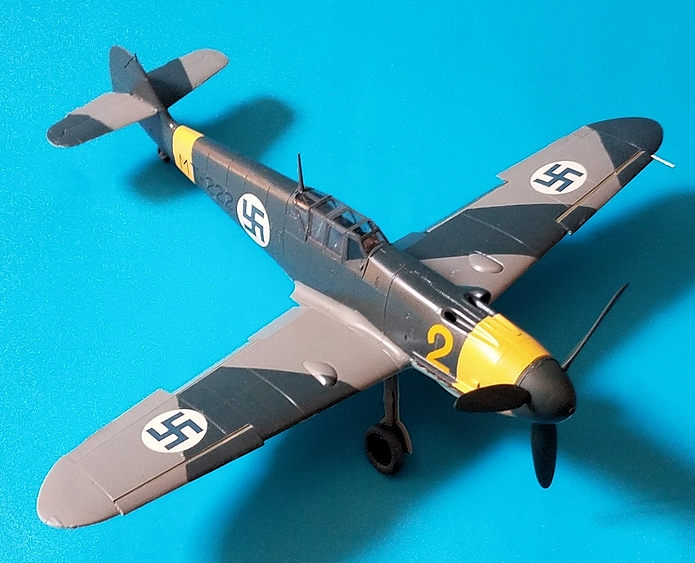 From Eduard's Mersu kit instructions: "Eino Ilmari "Illu"
Jutilainen, the most successful fighter pilot of Finland, was born at Lieksa on
February 21st 1914. He received flying training in 1935-1936, and on February
16th 1937, was posted to LLv 12. He was transferred on March 3rd 1939 as
kersantti to LLv 24, equipped with Fokkers D.XXI. Here he rose to the rank of
Ientomestari. On February 2nd, 1943, Juutilainen was transferred to LeLv 34.
This unit was equipped with Bf 109Gs. After the war, he served with HLeLv 33 and
on May 16th 1947, resigned from duty, but enlisted yet again on Septermber 8th
1948 for ten months to PLeLv 41, taking twin engine courses. In civil life he
made his living as a small plane pilot. Juutilainen died on his birthday in
1999. During both wars he flew 437 missions and shot down 94 enemy aircraft."
From Eduard's Mersu kit instructions: "Eino Ilmari "Illu"
Jutilainen, the most successful fighter pilot of Finland, was born at Lieksa on
February 21st 1914. He received flying training in 1935-1936, and on February
16th 1937, was posted to LLv 12. He was transferred on March 3rd 1939 as
kersantti to LLv 24, equipped with Fokkers D.XXI. Here he rose to the rank of
Ientomestari. On February 2nd, 1943, Juutilainen was transferred to LeLv 34.
This unit was equipped with Bf 109Gs. After the war, he served with HLeLv 33 and
on May 16th 1947, resigned from duty, but enlisted yet again on Septermber 8th
1948 for ten months to PLeLv 41, taking twin engine courses. In civil life he
made his living as a small plane pilot. Juutilainen died on his birthday in
1999. During both wars he flew 437 missions and shot down 94 enemy aircraft."
| THE KIT |
This kit from Eduard comes in a top opening box, with the boxart of Bf 109G-2/Trop "Black 2" having shot down a Spitfire above the North African desert. Inside the box we're greeted with a two bags, one big containing the seven sprues of the aircraft, and a smaller ziploc styled bag, containing the clear parts. Included in the kit are a set of cabuki masks for the clear parts and a small fret of photoetch pieces.
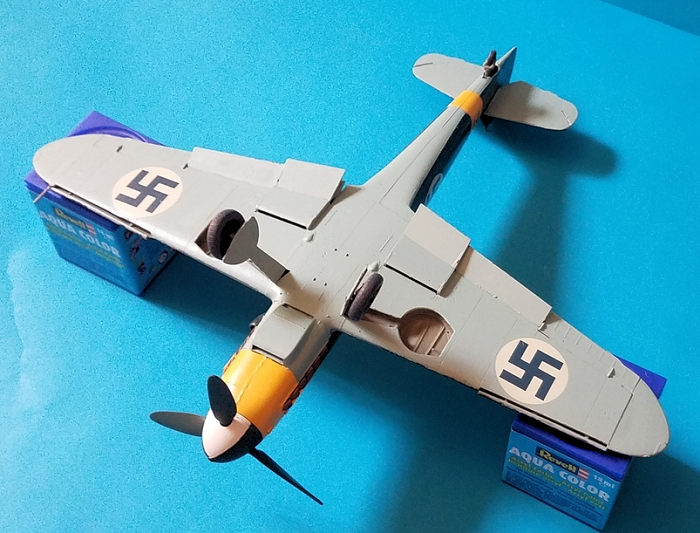 There're a total of five decal options:
There're a total of five decal options:
Bf 109G-2/Trop "Black 2," Matmata (Tunisia), early 1943. Painted in RLM 79/78 with squiggles of RLM 80.
Bf 109G-2/R6 "Yellow 10," Hans Döbrich, 6/JG5, Alakurtti, Finland, February 1943. Painted in RLM 74/75/76/04 with a white distemper camouflage.
Bf 109G-2/R6 "Yellow 5," Walter Krupinski, 6/JG52, Maykop, Soviet Union, October 1942. Painted in RLM 74/75/76/04.
Bf 109G-2/R6 "Black Chevrons and Bars," Hans Hahn, II/JG54, Rjelbitzy, Soviet Union, January 1943. Painted in RLM 74/75/76/04 with a white distemper camouflage.
Bf 109G-2/R6 "White 1," Wolf Dieter Huy, 7/JG77, Tanyet Harun, Egypt, October 1942. Painted in RLM 74/75 but covered in RLM 70/71. Undersides in RLM 76.
| CONSTRUCTION |
I began by painting all the cockpit pieces in RLM 66 (Revell 78). These pieces were the cockpit floor, the seat, backseat and control stick. With those pieces dry, I glued them all to the cockpit floor. The rudder pedals were painted in silver (Revell 91) and installed.
Next came the wings. Eduard's 82116 Bf 109G-2
comes with two different sets of upper wings, ones with the wing wheel bulges
seen since the Bf 109G-4 onwards, and one set without them. Since I had decided
to build my plane as Eino Ilmari Juutilainen's aircraft, I chose to use the
win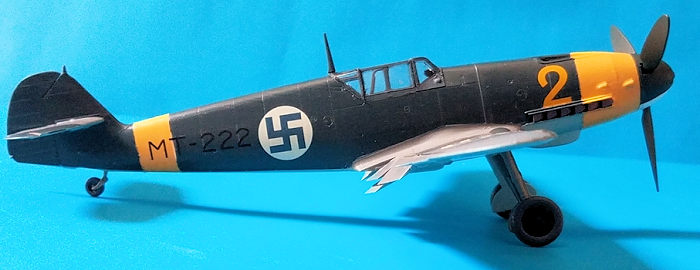 gs with the bulges. I first built the wheel wells, which Eduard provides as
four different pieces, a bit fiddly but with positive location points. These
were glued to the bottom wing and left aside to dry. When dry, I glued the upper
wing halves to the lower one.
gs with the bulges. I first built the wheel wells, which Eduard provides as
four different pieces, a bit fiddly but with positive location points. These
were glued to the bottom wing and left aside to dry. When dry, I glued the upper
wing halves to the lower one.
I then began working on the fuselage. I first glued all the fuselage pieces, and then painted them in RLM 66. The instrument panel was painted flat black and glued to one of the fuselage halves. Once all of this was dry, I glued the tailwheel and cockpit to the right fuselage half. I also glued at this time the exhausts parts (I18 and I16). The gun breeches were also glued to the cowling and left to dry. Once I had everything more of less dry, I glued the fuselage halves together, and taped them to let the glue set.
Once the glue had set, I glued the horizontal stabilizers, the wings and rudder to the fuselage. Ailerons, flaps and slats were all glued together at this point. The underwing radiators were glued too. The nose oil cooler was also built up and glued to the underside of the nose.
| COLORS & MARKINGS |
I had decided to use the markings of the Hasegawa Bf 109G-2 "Finnish Air Force" kit. That kit comes with decals for Juutilainen's aircraft.
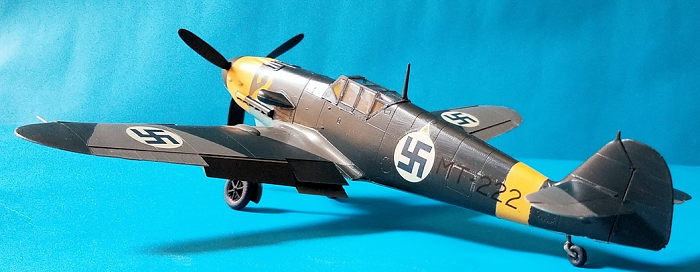 I began by painting the yellow bits of the
fuselage (yellow bands in the nose and fuselage band). I then masked the yellow
areas and painted the entirety of the fuselage in RLM 74 (Revell 69). The wings
were masked and painted in RLM 74 and 75 (Revell 47). The undersides of the
aircraft were painted in RLM 76 (Revell 49), with the wingtips being painted in
yellow too. The kit was the brushed with two coats of Revell's clear varnish to
prepare the surface for the decals. Once all the decals were applied, I coated
the aircraft with two brushed coats of Revell's matt varnish.
I began by painting the yellow bits of the
fuselage (yellow bands in the nose and fuselage band). I then masked the yellow
areas and painted the entirety of the fuselage in RLM 74 (Revell 69). The wings
were masked and painted in RLM 74 and 75 (Revell 47). The undersides of the
aircraft were painted in RLM 76 (Revell 49), with the wingtips being painted in
yellow too. The kit was the brushed with two coats of Revell's clear varnish to
prepare the surface for the decals. Once all the decals were applied, I coated
the aircraft with two brushed coats of Revell's matt varnish.
Final bits involved painting the landing gear struts in RLM 02, the wheels and the clear parts. Thanks to the canopy masks, painting them was a breeze. The tyres of the kit were painted in Revell Tank Grey, and the wheel hubs in flat black.
| CONCLUSIONS |
Eduard's kit has everything you may need to build the definitive kit of the 109 in 1:48. I didn´t use the photoetch pieces, and I still came up with a decent replica of the Bf 109G-2.
19
March 2021 Copyright ModelingMadness.com. All righsts reserved.
If you would like your product reviewed fairly and fairly quickly, please contact the editor or see other details in the
Note to
Contributors.